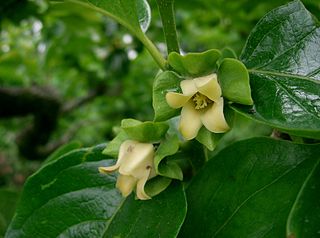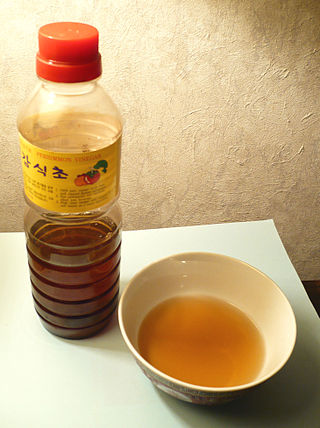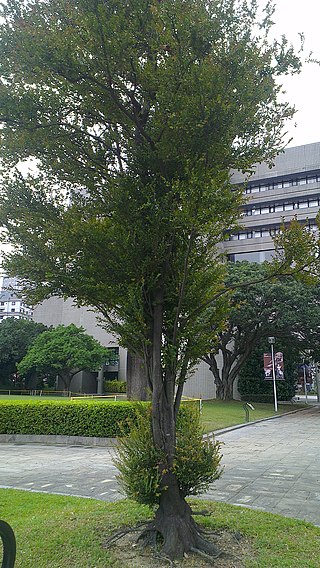
The persimmon is the edible fruit of a number of species of trees in the genus Diospyros. The most widely cultivated of these is the kaki persimmon, Diospyros kaki – Diospyros is in the family Ebenaceae, and a number of non-persimmon species of the genus are grown for ebony timber. In 2019, China produced 75% of the world total of persimmons.

Diospyros is a genus of over 700 species of deciduous and evergreen trees and shrubs. The majority are native to the tropics, with only a few species extending into temperate regions. Individual species valued for their hard, heavy, dark timber, are commonly known as ebony trees, while others are valued for their fruit and known as persimmon trees. Some are useful as ornamentals and many are of local ecological importance. Species of this genus are generally dioecious, with separate male and female plants.

Diospyros virginiana is a persimmon species commonly called the American persimmon, common persimmon, eastern persimmon, simmon, possumwood, possum apples, or sugar plum. It ranges from southern Connecticut to Florida, and west to Texas, Louisiana, Oklahoma, Kansas, and Iowa. The tree grows wild but has been cultivated for its fruit and wood since prehistoric times by Native Americans.

Diospyros mespiliformis, the jackalberry, is a large dioecious evergreen tree found mostly in the savannas of Africa. Jackals are fond of the fruit, hence the common names. It is a member of the family Ebenaceae, and is related to the true ebony and edible persimmon.

Diospyros kaki, the Oriental persimmon, Chinese persimmon, Japanese persimmon or kaki persimmon, is the most widely cultivated species of the genus Diospyros. Although its first botanical description was not published until 1780, D. kaki is among the oldest cultivated plants, having been in use in China for more than 2000 years.

Diospyros blancoi,, commonly known as velvet apple, velvet persimmon, kamagong, or mabolo tree, is a tree of the genus Diospyros of ebony trees and persimmons. It produces edible fruit with a fine, velvety, reddish-brown fur-like covering. The fruit has a soft, creamy, pink flesh, with a taste and aroma comparable to peaches.

Persimmon vinegar is a vinegar made from Oriental persimmon. Called gam-sikcho (감식초) in Korean, it is a traditional condiment, food ingredient, and beverage base in Korean cuisine.

Diospyros pentamera is a common rainforest tree in the Ebony or Persimmon family (Ebenaceae) growing from near Batemans Bay in New South Wales to the Atherton Tableland in tropical Queensland, Australia. It is commonly known as the myrtle ebony, black myrtle, grey plum or grey persimmon.

Diospyros texana is a species of persimmon that is native to central, south and west Texas and southwest Oklahoma in the United States, and eastern Chihuahua, Coahuila, Nuevo León, and Tamaulipas in northeastern Mexico. Common names include Texas persimmon, Mexican persimmon and the more ambiguous "black persimmon". It is known in Spanish as chapote, chapote manzano, or chapote prieto, all of which are derived from the Nahuatl word tzapotl. That word also refers to several other fruit-bearing trees.

Pseudocercospora is a genus of ascomycete fungi. An anamorphic version of the genus Mycosphaerella, Pseudocercospora species are plant pathogens, including the causal agent of the so-called South American leaf blight of the rubber tree. The widely distributed genus has been estimated to contain over 1100 species, concentrated predominantly in tropical regions. Pseudocercospora was circumscribed by Italian-Argentinian botanist Carlos Luigi Spegazzini in 1910.
Ichneumenoptera chrysophanes, the clearwing persimmon borer, is a moth of the family Sesiidae. It is found from Cairns in Queensland to Canberra in the Australian Capital Territory.

Diospyros dichrophylla (Gand.) De Winter is a Southern African tree belonging to the ebony family of Ebenaceae and closely related to the Persimmon.
Diospyros dictyoneura is a tree in the family Ebenaceae. It grows up to 30 metres (100 ft) tall. The fruits are ellipsoid, up to 4.5 cm (2 in) long. The specific epithet dictyoneura is from the Greek meaning "net of nerves", referring to the leaf veins. Habitat is lowland mixed dipterocarp forests. D. dictyoneura is found from Indochina to west Malesia. In order to grow, the diospyros dictyoneura requires access to the sun. Its leaves are deciduous, and it attracts bees and birds.

Diospyros maritima is a tree in the family Ebenaceae. The specific epithet maritima means "by the sea", referring to the tree's habitat.

Homona magnanima, the Oriental tea tortrix moth, is a species of moth of the family Tortricidae. It is found in Japan, Taiwan, China and Vietnam.
Stathmopoda masinissa, the persimmon fruit moth, is a moth of the family Stathmopodidae. The species was first described by Edward Meyrick in 1906. It is a serious pest on several persimmon species. It is found in several Old World countries Japan, Korea, Australia, Sri Lanka, Thailand and China.
Mycovellosiella is a genus of fungi belonging to the family Mycosphaerellaceae.

Diospyros vaccinioides, the small persimmon, is a herbaceous plant, a member of the Ebenaceae family. This plant is mainly found in China and it is known to thrive in subtropical biomes.

Diospyros rhombifolia, the diamond-leaf persimmon or princess persimmon, is a species of flowering plant in the family Ebenaceae, native to southeast China. A shrub or tree reaching 8 m (26 ft), and hardy to USDA zone 7b, it is widely cultivated as an ornamental for its small leaves and attractive orange fruit.














